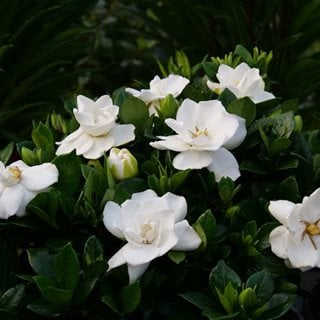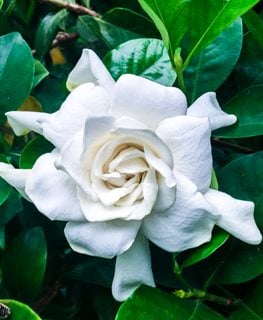How to Grow Gorgeous Gardenias
Whether you grow them outdoors in the garden or indoors as houseplants, gardenia bushes can thrive just about anywhere if you are willing to indulge themIn the languid warmth of late spring and early summer, many gardens in the South are filled with the heady perfume of gardenia plants in bloom. But even if you don’t live in a sultry southern climate, you can still enjoy the creamy white flowers and intoxicating fragrance of these striking evergreen shrubs by giving them the subtropical conditions they love.
On this page: Basics | Planting | Gardenia Care | Growing Indoors | Pictures | Design Ideas
On this page:
- BASICS
- HOW TO PLANT GARDENIAS
- GARDENIA CARE
- GROWING GARDENIAS INDOORS
- GARDENIA PICTURES
- DESIGN IDEAS
BASICS
Botanical name:
Gardenia spp.; the most common garden species is G. jasminoides (syn. G. augusta, G. grandiflora)
Common names:
Gardenia or Cape Jasmine
Zones:
8-11; with a few varieties hardy to Zone 7
Height/spread:
Upright, spreading, or bushy habit; 3 to 8 feet tall and wide, depending on the cultivar. Dwarf varieties reach just 6 to 24 inches tall.
Exposure:
Full sun to partial shade, with protection from hot afternoon sun
Bloom period:
May-June, with some varieties experiencing sporadic rebloom into fall
Flowers:
Gardenia flowers are typically white, with single, semi-double, or double blossoms ranging from 2 to 5 inches in diameter. Some cultivars, such as ‘Golden Magic’, have buttery yellow blossoms.
Foliage:
Glossy, dark green leaves 2 to 4 inches long will remain attractive throughout the year.
Are gardenias poisonous?
Gardenias are poisonous to pets and children, containing a number of toxic properties including saponins and glycosides.
Are gardenias deer resistant?
Gardenias are regarded as deer-resistant, though deer may graze on plants they wouldn’t otherwise if other food sources are scarce.
PLANTING GARDENIAS OUTDOORS
When to plant:
As with many spring-blooming shrubs, fall is the best time for planting because it gives the root system more time to get established.
Where to plant:
Plant gardenias in a site that receives full sun to partial shade, with protection from hot afternoon sun. Provide good air circulation; in cooler climates, protect from hard freezes and drying winter winds.
How to plant:
Loosen soil in the planting area and amend with compost or other rich organic matter. Provide good drainage. If plants are pot-bound, gently tease out the roots. Dig a hole twice as wide and slightly deeper than the root ball and place in the planting hole so the top of the root ball is at or slightly above ground level to allow for settling. Fill in the hole with soil, tamp down gently, and water thoroughly. Water plants regularly until established.
For containers:
Make sure pots have adequate drainage holes. Use a high quality all-purpose potting soil that drains well.
GARDENIA CARE

Gardenias bloom best when planted in well-drained, acidic soil. Photo by: Paul Brennan | Dreamstime.
Temperature and humidity:
The ideal temperature range for gardenias is 60-70 degrees F, though they can survive down to 15 degrees F. Plants may experience stress, damage or failure to develop flower buds in extreme temperatures. Gardenias prefer moderate to high humidity of at least 50%.
Soil:
Gardenia requirements for soil include good drainage, amendment with compost or other rich organic matter, and an acidic pH of 4.5-6.0. Mulch plants to keep them moist (but be sure to keep it away from the crown of the plant). Gardenias have shallow root systems, so avoid cultivating around the root zone once they are established.
Watering:
Gardenias like consistently moist but not soggy soil, requiring about an inch of water per week. Containers dry out more quickly and will need more frequent watering, especially during hot, dry spells.
Amendments and fertilizer:
In spring, apply a slow-release fertilizer formulated for acid-loving plants (such as azaleas) according to instructions. Look for a formulation that includes iron and magnesium. Fertilize again in late June. Water plants well before and after fertilizing. Cease fertilizing by fall to avoid cold damage to new growth.
Pruning:
Prune gardenia shrubs in summer after they have finished flowering so you don’t remove any buds. Before pruning, make sure the variety you’re growing only blooms once and has completed its blooming cycle. If it does bloom more than once, prune off faded flowers just below the leaf node to encourage repeat blooming.
Pests and diseases:
Gardenias are susceptible to several pests, including whiteflies, mealybugs, scale, aphids and spider mites. Diseases include powdery mildew, anthracnose, sooty mold, or leaf spot. For guidance on controlling and troubleshooting these problems, see Gardenia Insects & Related Pests and Gardenia Diseases and Other Problems from the Clemson University Cooperative Extension Service.
GROWING GARDENIAS INDOORS

Gardenias are popular houseplants for their attractive flowers, foliage and sweet scent. Photo by: Steffen Hauser / botanikfoto / Alamy Stock Photo.
“A gardenia is not the easiest plant to bring into bloom [indoors], though plants that are happy with their situation will often bloom in late spring and again in the fall. In between, they enjoy spending the summer outdoors in a shady spot,” says Barbara Pleasant, author of The Complete Houseplant Survival Manual.
Growing conditions:
Unless you have a greenhouse or sunroom, it will be difficult to give indoor plants enough sunlight and humidity to produce flower buds. Pleasant recommends placing plants in a south-facing window where they will receive at least four hours of sunlight daily, but not strong midday sun. To increase humidity, place a humidifier in the room or place your pots in a tray of damp pebbles. Cool nighttime temperatures (60 degrees F) and warm daytime temperatures (75 degrees F) will promote better flowering.
Soil:
Use a well-drained, acidic soil, such as a mix of 2 parts potting soil and 1 part peat moss.
Watering:
Keep soil evenly moist at all times, but do not overwater or allow puddling.
Fertilizing:
Feed every two weeks with a balanced houseplant fertilizer that contains micronutrients, especially iron, or use a slow-release azalea fertilizer. A lack of iron or a soil that’s too alkaline can lead to yellowing leaves.
Repotting:
Repot young plants annually in late winter until the roots fill 8-inch pots, then repot every two years to refresh the soil.
Alternative houseplant:
If you struggle to grow gardenias, try Mitriostigma axillare, the African gardenia, with sweetly-scented flowers that bloom all year. Many gardeners find it very easy to care for.
GARDENIA VARIETIES
DESIGN IDEAS
- Use gardenias as hedge plants along sidewalks, entryways, and fences.
- Place specimen plants anywhere in the garden where their fragrance can be appreciated.
- Low-growing spreading cultivars, such as ‘Radicans’ are attractive in borders or as groundcovers.
- Potted gardenias are perfect for porches and patios, where you can shelter them from harsh sunlight and winds and easily move them indoors if desired (see our guide to bringing outdoor plants inside). Tree forms are especially lovely when grown in containers, and add sophistication to formal garden designs.
- Create a cocktail-hour garden by combining gardenias with other white-flowering plants that will reflect the moonlight and perfume the night air (see Creating a Magical Moon Garden). Gardenias are most fragrant at sunset and during the early evening hours. The moonlit white flowers will also attract nocturnal moths, which serve as pollinators.
- Indoors, you can control the size of gardenias by growing them in smaller containers. In fact, a slightly pot-bound gardenia will often bloom more prolifically. Gardenias also make excellent bonsai trees if you prune and train them into the desired shape.
See more fragrant plants to grow: 20 Fragrant Flowering Plants
Related:
Southern Gardens
Tropical Gardens













